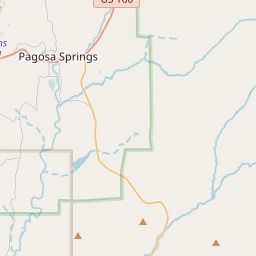Pagosa Springs
Historical marker location:
250 Hot Springs Blvd, Pagosa Springs, Colorado
( Marker can be reached from Hot Springs Blvd.)







© OpenStreetMap contributors
Loading...
Searching for other points of interest within 3 miles of this location.The city of Denver was named after Kansas territorial governor James W. Denver, even though he never actually visited the area. The name was chosen by early settlers in the area.
About Archuleta County
Archuleta County Timeline
Archuleta County, located in southwestern Colorado, has a rich history dating back thousands of years. The region was originally inhabited by various Native American tribes, including the Utes and Navajos, who relied on the area's natural resources for their livelihoods. Spanish explorers arrived in the region in the 16th century, but permanent settlement did not occur until the 19th century.
In the mid-1800s, Hispanic settlers began to establish homesteads and ranches in the area, attracted by the fertile land and abundant water sources. The region's agricultural potential led to the establishment of several small communities, including Pagosa Springs, which would become the county seat. These early settlers faced challenges such as harsh weather conditions and hostile relations with Native American tribes.
Archuleta County experienced a boom in the late 19th and early 20th centuries when valuable mineral deposits, including gold and silver, were discovered in the nearby mountains. Mining became a major industry, attracting thousands of settlers in search of fortune. However, the mining boom was relatively short-lived, and by the early 20th century, the industry had declined significantly.
Today, Archuleta County is known for its scenic beauty and outdoor recreational opportunities. The county's economy has diversified, with tourism, agriculture, and small-scale mining being the main industries. Historical landmarks and cultural heritage sites, including ancient cliff dwellings and historic buildings, attract visitors from around the world. Archuleta County's rich history continues to be preserved and celebrated by its residents and visitors alike.
In the mid-1800s, Hispanic settlers began to establish homesteads and ranches in the area, attracted by the fertile land and abundant water sources. The region's agricultural potential led to the establishment of several small communities, including Pagosa Springs, which would become the county seat. These early settlers faced challenges such as harsh weather conditions and hostile relations with Native American tribes.
Archuleta County experienced a boom in the late 19th and early 20th centuries when valuable mineral deposits, including gold and silver, were discovered in the nearby mountains. Mining became a major industry, attracting thousands of settlers in search of fortune. However, the mining boom was relatively short-lived, and by the early 20th century, the industry had declined significantly.
Today, Archuleta County is known for its scenic beauty and outdoor recreational opportunities. The county's economy has diversified, with tourism, agriculture, and small-scale mining being the main industries. Historical landmarks and cultural heritage sites, including ancient cliff dwellings and historic buildings, attract visitors from around the world. Archuleta County's rich history continues to be preserved and celebrated by its residents and visitors alike.
Archuleta County Timeline
This timeline provides a condensed summary of the historical journey of Archuleta County, Colorado.
- 1851: Ute Native American tribes inhabit the land that is now Archuleta County.
- 1874: The first permanent non-Native American settlement is established in the area.
- 1880: Archuleta County is officially organized and named after Judge Carlos M. Archuleta.
- 1881: Pagosa Springs is established as the county seat.
- 1890: The narrow-gauge Denver and Rio Grande Railroad reaches Pagosa Springs, boosting the local economy and facilitating growth.
- 1911: The Great Pagosa Hot Springs is acquired by the U.S. Forest Service and designated as a national reservation.
- 1950s-1960s: The construction of Navajo Dam on the San Juan River brings economic opportunities to the county.
- 1970s: Archuleta County experiences a surge in population and tourism due to its natural beauty and outdoor recreational activities.
- 1992: The West Fork Complex Fire, one of the largest wildfires in Colorado history, burns large areas of Archuleta County.
- 2000s: Archuleta County continues to be a popular destination for outdoor enthusiasts and retirees, contributing to its steady growth and development.